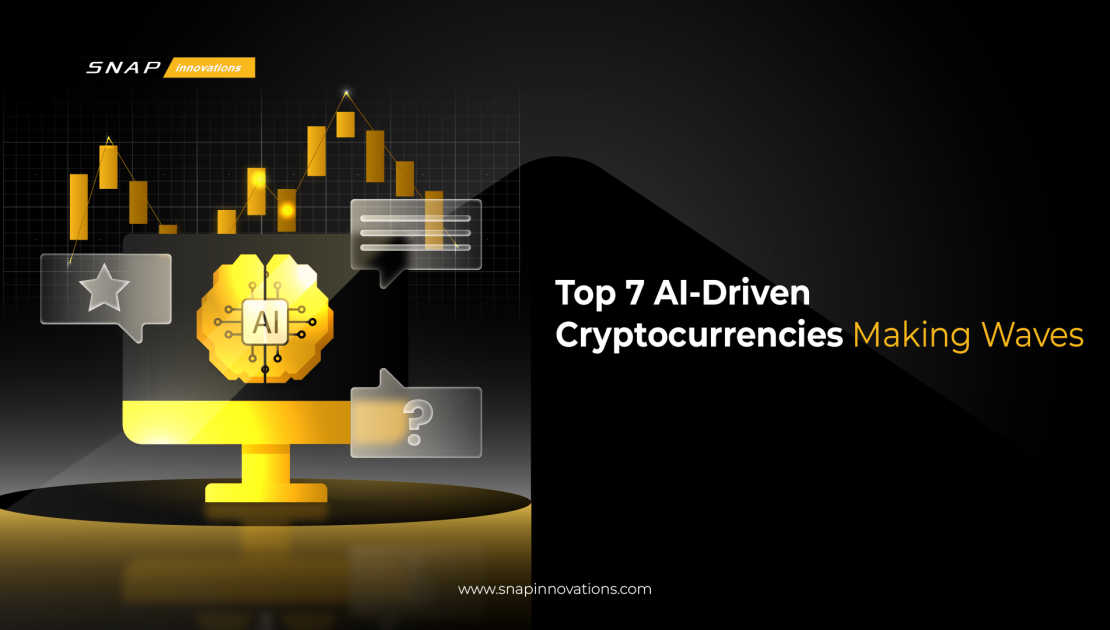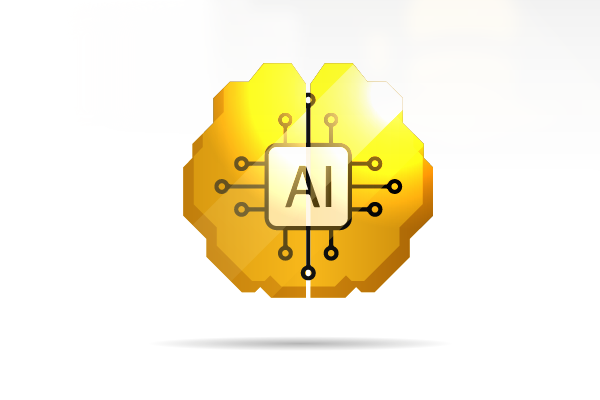Top 10 AI Driven Cryptocurrencies to Consider in 2026

Artificial Intelligence is rapidly becoming the main engine behind the next era of technological and economic progress, and this shift is especially visible in the world of cryptocurrency. As the need for decentralized compute, autonomous agents, and intelligent applications continues to rise, a new generation of blockchain projects is emerging to meet these demands.
These AI driven cryptocurrencies are not using AI as a simple marketing term. Instead, they are building essential infrastructure that enables smarter networks, advanced automation, secure data exchange, and entirely new digital economies. In the year 2026, understanding which AI crypto projects are leading this movement is crucial for anyone who wants to stay competitive in the fast changing world of Web3.
What is an AI Driven Cryptocurrency?
 An AI driven cryptocurrency is a blockchain based token that supports AI related services whether it’s decentralized compute, machine learning inference, training, or autonomous agent coordination. These tokens go beyond basic monetary use and integrate into core AI operations. They’re used for paying node operators, incentivizing data contributions, rewarding inference processing, or even governing AI ecosystems.
An AI driven cryptocurrency is a blockchain based token that supports AI related services whether it’s decentralized compute, machine learning inference, training, or autonomous agent coordination. These tokens go beyond basic monetary use and integrate into core AI operations. They’re used for paying node operators, incentivizing data contributions, rewarding inference processing, or even governing AI ecosystems.
Whereas traditional cryptocurrencies like Bitcoin or Litecoin serve as digital money, AI crypto tokens act more like fuel for intelligent systems. They allow decentralized AI protocols to scale in a trustless environment while providing an incentive for participants to contribute resources like data, models, or GPU power. These ecosystems also often include staking, DAO governance, and reputation layers to ensure high-quality outputs and alignment of incentives.
Top 10 AI Driven Cryptocurrencies to Consider in 2026

Artificial Intelligence (AI) and blockchain are converging fast. As AI becomes more embedded in every aspect of digital life, blockchains that can support AI-native workloads from agent-based systems to decentralized compute stand to gain significantly. In 2026, certain cryptocurrencies look particularly well positioned to benefit from this convergence. Here are 10 AI-driven crypto projects to watch, from next gen Layer 1s to decentralized AI marketplaces and compute networks.
1. HeLa (HeLa Labs)
HeLa is a modular Layer-1 blockchain built with AI at its core. Its mission is to give users full control of their AI agents, data, identity, and compute all on one chain.
Key Features
- Modular blockchain architecture (separating consensus, storage, execution, assets)
- EVM compatibility for easier development
- Stablecoin (fiat-backed) for gas, reducing volatility in transaction costs
- Decentralized Identity (DID), giving users control over their data
- Privacy-preserving infrastructure to secure AI workloads
AI Use Cases
- On-chain AI agents that can transact, learn, and earn yield
- Decentralized compute marketplace, where users provide compute power (e.g., GPU) and are rewarded
- AI-driven DeFi, gaming, and autonomous applications
Potential in 2026
HeLa could become a foundational blockchain for the AI economy, especially as more developers build agent-native applications. Its stable-fee model and modular design make it a very attractive infrastructure for real-world AI use.
2. NEAR Protocol (NEAR)
NEAR Protocol is positioning itself as “the blockchain for AI.” It aims to support autonomous AI agents, encrypted compute, and seamless execution across chains.
Key Features
- High scalability via sharding (Nightshade)
- Trusted Execution Environments (TEEs) for encrypted AI inference
- Chain Abstraction & Intents: allowing AI agents to make cross-chain transactions easily
- On-chain agent infrastructure (“Shade Agents”)
AI Use Cases
- Encrypted model execution and private inference (sensitive data stays protected)
- Autonomous AI agents that negotiate, act, and transact on behalf of users
- Large-scale open-source model training through NEAR’s AI Research Hub
Potential in 2026
NEAR is very well-placed to host AI-native dApps. Its AI Agent Fund (launched by NEAR Foundation) can accelerate development, while its infrastructure supports secure, user-owned AI in a multichain world.
3. Render Network (RNDR)
Render Network is a decentralized GPU marketplace. Users can contribute GPU capacity, and developers or creators can tap into that compute for rendering or AI workloads.
Key Features
- Marketplace for GPU compute
- Token incentives for providing GPU time
- Flexible compute allocation (3D rendering, machine learning, inference)
- Reputation or workload-based matching
AI Use Cases
- Training large AI models on distributed GPUs
- AI inference tasks performed on decentralized nodes
- Rendering for generative AI art, VFX, simulation, and more
Potential in 2026
With the explosion of generative AI and demand for compute, Render’s decentralized model could become a major part of the infrastructure for AI development and deployment especially for teams that don’t have massive centralized data centers.
4. Fetch.ai (FET)
Fetch.ai builds a network of autonomous agents that operate in a decentralized economy, executing tasks, negotiating, and learning over time.
Key Features
- Agent-based architecture (multi-agent systems)
- On-chain identity and discovery layer
- AI-native smart contracts
- Interoperability with other blockchains
AI Use Cases
- Autonomous economic agents for logistics, finance, and IoT
- Predictive markets using AI to forecast demand or behavior
- Coordination and automation between devices or businesses
Potential in 2026
As AI becomes more embedded in real-world systems (smart cities, supply chains), Fetch.ai could play a central role by allowing smart agents to act on behalf of users or enterprises.
5. Theta Network (THETA)
Theta Network is widely known for decentralized video streaming, but in the context of AI, it can support distributed computation and data sharing at the edge.
Key Features
- Edge nodes that contribute bandwidth and compute
- Incentivized network for content distribution
- High-throughput architecture for media and compute
- Token-based rewards for node operators
AI Use Cases
- Distributed inference on edge devices (e.g., AI for video analytics)
- Federated learning across edge nodes, using distributed data
- AI-enhanced content delivery, such as smart caching or predictive streaming
Potential in 2026
Edge AI is becoming increasingly powerful. Theta’s network could be used to run lightweight AI workloads close to users, reducing latency and central compute demands, especially for video and IoT applications.
6. Injective (INJ)
Injective is a fully decentralized Layer-1 and Layer-2 blockchain focused on decentralized finance (DeFi), but it can also support AI-driven financial markets and predictive systems.
Key Features
- High-performance, interoperable blockchain
- Support for complex smart contracts and order books
- Custom market creation (derivatives, prediction markets)
- Cross-chain compatibility
AI Use Cases
- AI-driven trading bots and hedge strategies
- Predictive markets where AI forecasts future events or prices
- Autonomous market-making powered by AI
Potential in 2026
Injective could become a hub for highly sophisticated AI-powered financial systems. As DeFi continues to adopt AI for risk assessment, strategy automation, and prediction, Injective’s flexibility could be a huge advantage.
7. Ocean Protocol (OCEAN)
Ocean Protocol is a data marketplace built for decentralized data sharing. It allows data providers and consumers to trade data securely and privately, which is a crucial input for AI.
Key Features
- Marketplaces for data sets
- Data tokens to represent data ownership or access rights
- Privacy-preserving mechanisms for data usage
- Tools for data monetization
AI Use Cases
- AI models training on high-quality, decentralized data
- Data providers monetizing their datasets via tokens
- Federated learning: models learn from data across different parties without centralizing the raw data
Potential in 2026
As demand for quality, privacy-safe data grows, Ocean could be central to unlocking AI innovation. Its data marketplace can support both small and large AI developers who need access to diverse data sources.
8. Bittensor (TAO)
Bittensor is a decentralized protocol where AI models compete and collaborate in a peer-to-peer intelligence marketplace. Contributors earn TAO tokens by providing compute, validation, or model outputs.
Key Features
- Subnet architecture: specialized AI tasks run on different sub-networks
- Yuma consensus (“Proof of Intelligence”), rewarding useful AI contributions
- Fixed supply tokenomics (similar to Bitcoin model)
- Open participation for validators, miners, and subnet creators
AI Use Cases
- Collaborative training of AI models across a decentralized network
- Inference markets: models serve predictions and are evaluated by validators
- Commercialization of AI services: contributors can monetize their intelligence or compute
Potential in 2026
Bittensor may become a core platform for decentralized AI research and deployment. By incentivizing useful model contributions, it fosters a meritocratic intelligence ecosystem. Its fixed-supply token and peer ranking could make it very attractive for AI developers and researchers.
9. SingularityNET (AGIX)
SingularityNET is a decentralized marketplace for AI services. It allows developers to publish, discover, and monetize AI models and applications.
Key Features
- AI service marketplace
- Token-based governance
- Interoperable AI modules
- Incentive mechanisms for service providers
AI Use Cases
- AI developers offering models (e.g., NLP, vision, forecasting) as a service
- Integration of multiple AI capabilities (agents, reasoning, learning)
- Decentralized orchestration of AI workflows across providers
Potential in 2026
As the demand for AI services grows, especially in Web3, SingularityNET could become a go-to platform for decentralized AI. Its marketplace model makes it easy for independent developers to monetize AI, and for users to access a broad variety of AI tools.
10. The Graph (GRT)
The Graph is a decentralized indexing and query protocol for blockchain data. It enables rapid access to data, which is foundational for AI systems that need structured, reliable inputs.
Key Features
- Decentralized data indexing (subgraphs)
- Fast querying of blockchain data
- Incentive structure for indexers, curators, and delegators
- Integration with multiple blockchains
AI Use Cases
- Feeding AI models with indexed, structured blockchain data
- Real-time analytics and insights for on-chain AI agents
- Data pipelines for training AI that relies on Web3 data (transactions, events, user behavior)
Potential in 2026
As AI applications increasingly rely on on-chain data, The Graph is very likely to be a critical infrastructure layer. Without efficient data retrieval, AI models on blockchain would struggle to operate effectively.
Key Metrics & Characteristics to Compare
Evaluating AI cryptos requires more than just watching prices. Here are the main features to assess when choosing which ones to engage with or invest in.
Before you invest in or build with AI crypto tokens, consider these core characteristics. These determine long-term sustainability, utility, and value creation within each ecosystem.
1. AI Usage Volume
Tokens that are actually used for inference requests, agent coordination, or data access show real demand. Projects like Bittensor and Render see daily workloads processed on their networks — a strong sign of viability.
A token may have hype, but without real activity, it risks collapse. Metrics like inference requests, active models, or data transaction volumes help you assess this.
2. Tokenomics & Incentive Models
A sustainable token economy is critical. Are contributors rewarded fairly? Is there inflation or deflation built in? Are there utility-driven burns or staking requirements?
Strong projects design their tokenomics to encourage long-term behavior. For example, Bittensor’s model rewards useful model contributions, while Ocean requires data staking to ensure quality.
3. Ecosystem Maturity
Projects that already have integrations, enterprise pilots, or developer traction are less speculative. Fetch.ai, for example, has use cases in logistics and energy, while Ocean Protocol is deployed in healthcare and research.
Community strength, developer tools, and regular upgrades signal a growing ecosystem.
4. Technological Infrastructure
Can the network scale? Does it support low-latency AI workloads? Are off-chain and on-chain components well integrated?
Render’s GPU backend and NEAR’s sharded architecture are examples of platforms optimized for scale and speed — essential for AI applications.
5. Governance & Decentralization
Is governance handled through a DAO? Are users involved in decision-making? Projects like ASI aim to build democratic models of decentralized intelligence, with token-weighted voting and community-funded initiatives.
Tokens with strong governance mechanisms tend to evolve better in the face of market or regulatory changes.
Risks, Future Trends, and Strategic Advice
 Despite the excitement, AI cryptocurrencies come with real risks. However, with strategy and caution, you can navigate this evolving landscape effectively.
Despite the excitement, AI cryptocurrencies come with real risks. However, with strategy and caution, you can navigate this evolving landscape effectively.
The Road Ahead
The AI crypto space is speculative, fragmented, and experimental — but it’s also brimming with potential. Not all projects will survive, and some may pivot away from their original AI goals. As regulation increases and compute demands evolve, only those with adaptive, sustainable models will thrive.
However, the emergence of agent economies, tokenized AI services, and decentralized compute/data markets suggests a long-term trajectory that’s exciting and disruptive. The real winners will be those who focus on building real utility, not just riding hype cycles.
Strategic Advice
- Focus on Usage Metrics
Track model usage, GPU compute volumes, and real-world integrations. Platforms with daily active contributors, inference queries, or dataset downloads signal traction. - Diversify Your Exposure
Don’t put all your capital into just one type (e.g., compute). Spread across compute (Render), data (Ocean), and agents (Fetch, Virtuals) for a balanced exposure. - Understand Tokenomics Deeply
Read the whitepapers. Look for deflationary mechanisms, staking incentives, and contributor reward models. Avoid projects with unsustainable inflation. - Monitor Regulatory Trends
Stay updated on how global regulators are treating AI and crypto projects. Data privacy, IP, and model accountability will shape which platforms thrive. - Invest Responsibly
Treat AI crypto like early-stage tech startups: high risk, high potential reward. Allocate responsibly, and consider exit strategies when tokens hit 3x–5x multiples.
Conclusion
As AI continues to reshape every digital industry from finance and data to compute and autonomous agents the blockchain projects most aligned with this transformation are positioned for enormous growth. The ten AI driven cryptocurrencies highlighted here each contribute a crucial building block to the emerging decentralized AI ecosystem, whether through advanced Layer 1 infrastructure, GPU marketplaces, data sharing frameworks, or intelligence networks powered by autonomous agents.
While each project offers unique strengths and approaches, they all share a common vision: a future where AI is open, decentralized, user controlled, and seamlessly integrated with Web3 technology. For investors, developers, and innovators exploring the AI crypto frontier, these projects represent some of the most influential and forward-thinking platforms to watch closely in 2026 and beyond.
Muhammad Ermanja
I am a specialist in the financial technology industry, focusing on trading technology solutions and brokerage infrastructure. With over six years of experience, I consistently explore the development, implementation, and integration of multi-asset trading systems, low-latency platforms, and brokerage automation tools. My insights revolve around how technology can enhance execution speed, risk management, and overall operational efficiency for brokers and professional traders. Every analysis and article I create is grounded in research and real-world industry challenges, aiming to help financial institutions and trading firms build scalable, secure, and high-performing systems in the rapidly evolving landscape of modern finance.

